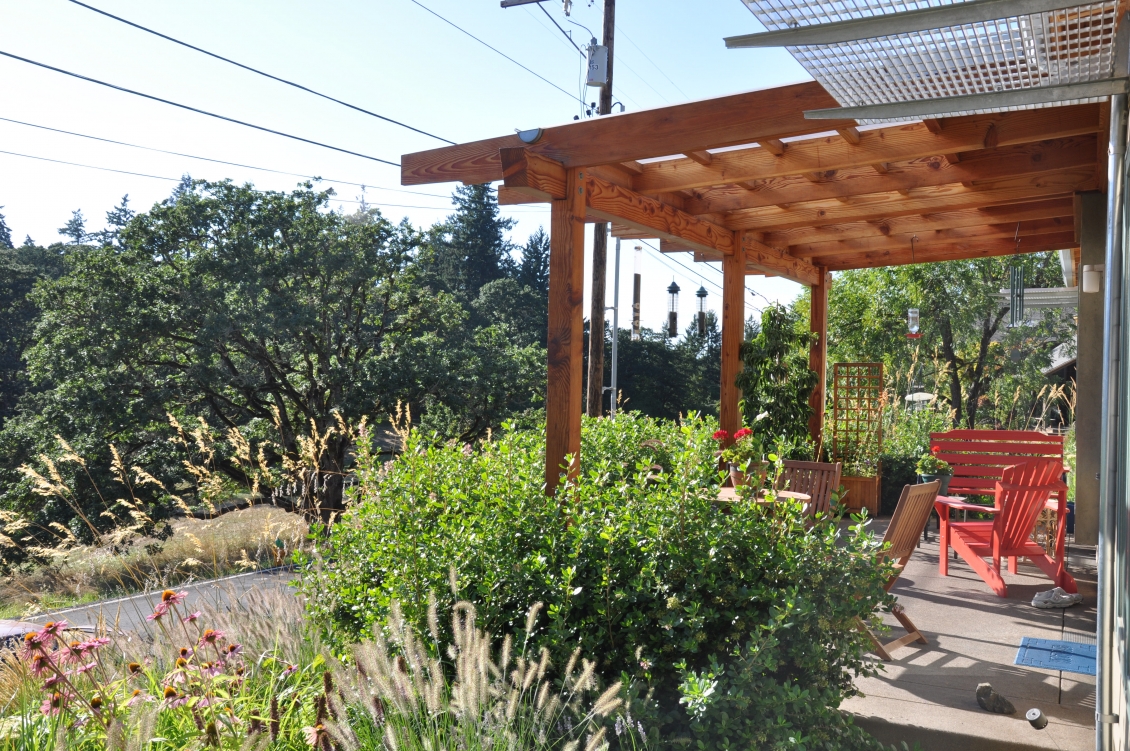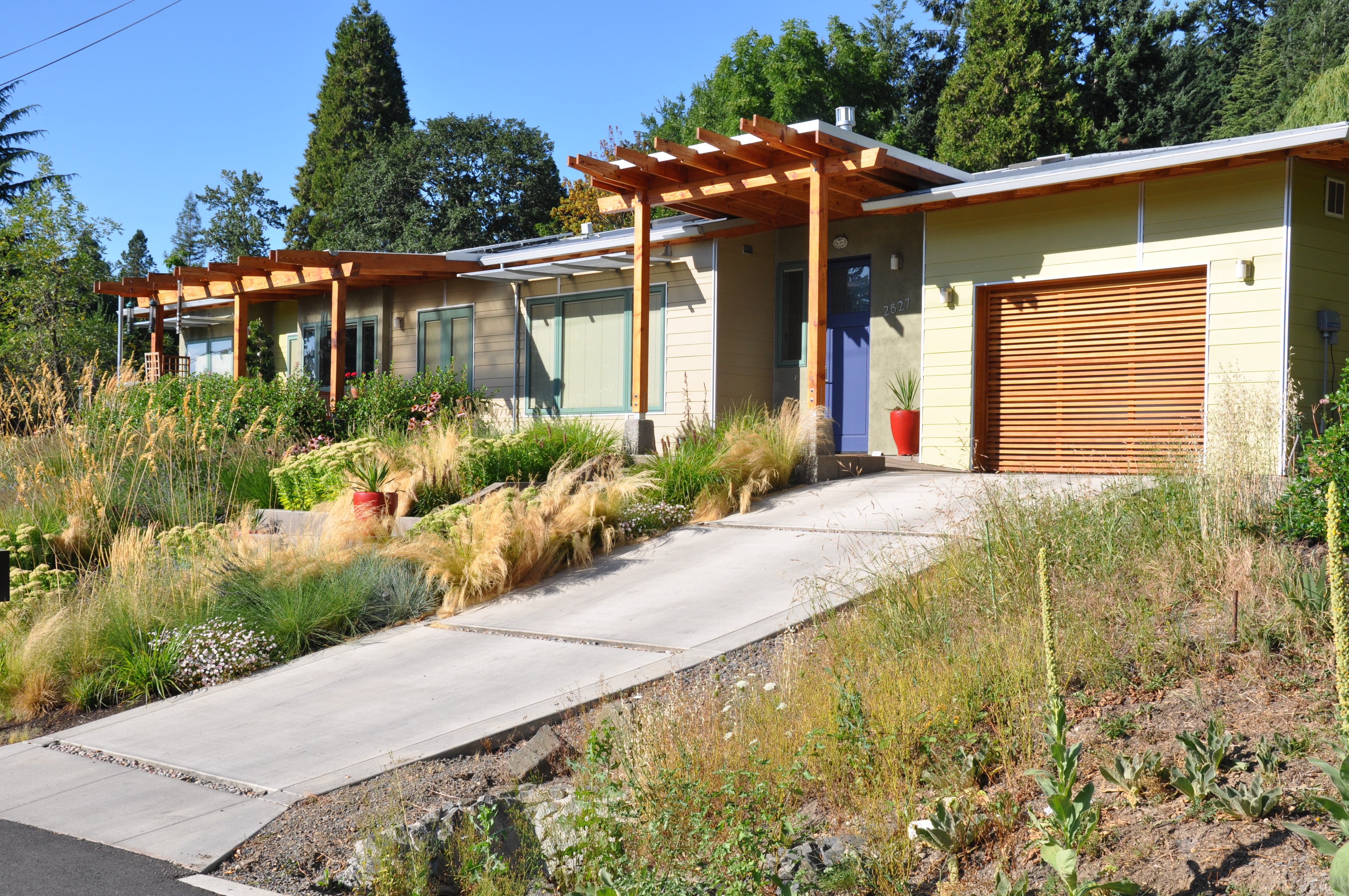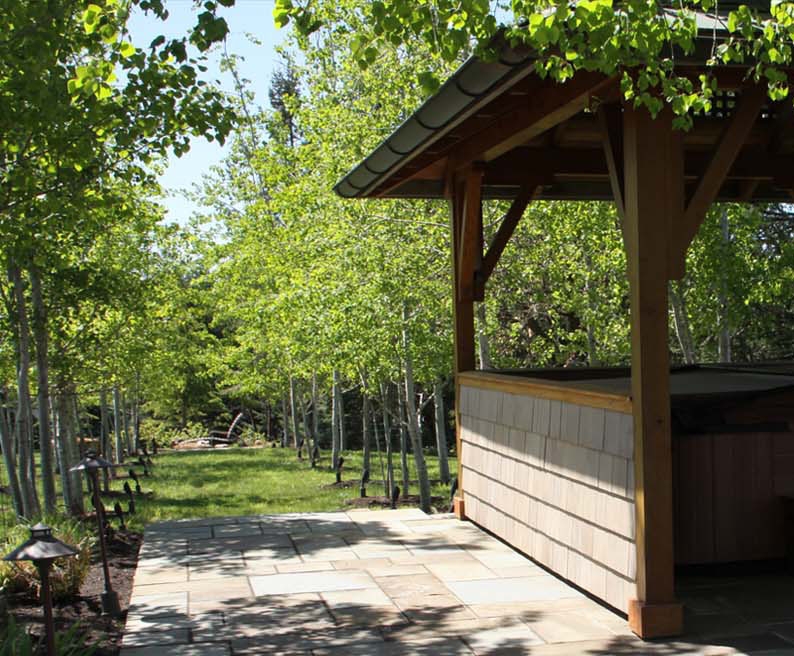
As the weather warms up here in Eugene, Oregon, we enjoy spending more time outside. For most homeowners, the privacy of a back yard provides the greatest opportunity for relaxation and enjoyment, while the front yard remains more formal and primarily serves as space for circulation. Despite the more public nature of the front yard, we at Lovinger Robertson Landscape Architects believe it is a rich canvas for outdoor living. Let’s delve into this frequently viewed but often overlooked space.

When visitors approach a house, the front yard is the first introduction to the home. It prepares guests for the character of the individual homeowner and responds to the vernacular of the neighborhood. Context plays a strong role in the perception of a front yard; an aesthetic that ties into the surrounding properties creates a powerful sense of neighborhood cohesion. The front yard also gives homeowners an opportunity to express their values to the public. A xeriscape or vegetable garden in the front yard communicates sustainable principles, and is all the more visible amidst a sea of lawns. A more subtle transition from the context, such as a turf-alternative like micro-clover, can create a dialogue with the neighbors and minimize the need for irrigation. Lawn space lends a serene respite and is a valuable element in design; however, the front yard can provide a richer experience when that lawn is thoughtfully combined with other types of vegetation.
While front gardens are generally considered a counterpoint to the more private back garden, not every property has an equal balance between these two realms. Corner lots or lots with large building setbacks often result in homes with ample front yards and meager or nonexistent back yards. In these instances, the role of the front yard should evolve to serve more private functions. Subdividing the garden space – either through careful arrangement of plants or through fences and hardscaping – can create outdoor rooms that extend privacy into the front space.
The front yard also is a valuable opportunity to physically and mentally transition from the public realm to the private realm. In a previous blog post, we explored the power of thresholds in creating meaningful outdoor rooms and transitioning into more personal spaces. The front garden is rich with design opportunities to shed the pressures of the larger world as you move toward the home. Close attention to the solar aspect and surrounding vegetation will help define the character and clarity of the entry, as will carefully choreographed outdoor lighting. The presence of vehicles strongly affects the cohesion of the front yard and entry experience; providing some separation between the car and the entrance to the home will preserve the serenity of the home, while maintaining ease of access is important for function. Thoughtfully balancing the many needs placed on the front yard results in a space that is simultaneously welcoming and thoroughly usable, expressing the personality of the homeowner and engaging with the character of the surrounding neighborhood.

Is this harsh winter weather giving you a bit of cabin fever and making you hunger for garden time? It’s a great time to start dreaming, but while you are stuck indoors, take the time to appreciate the architectural qualities of your home. A truly integrated garden will reflect the style and proportion of the architecture in the outdoor experience. We have written before about the role outdoor spaces play in providing beautiful and functional outdoor rooms; however, gardens can enhance the expression of your home in other ways.
Complement your home by paying close attention to the proportion and scale of the house, and extend those same design principles in your landscape. For example, tall evergreen trees that would dwarf a single-story bungalow can provide an appropriately scaled backdrop to a larger home. Likewise, if you have a large central room in your home, looking out onto a similarly proportioned outdoor space extends the indoor experience – visually in the winter and physically in the summer. It creates a harmonious composition, marrying the home and the garden. The use of similar proportions of space supports the continuity between the architecture and the garden.
In addition to mirroring the proportions of interior spaces, the composition of views from inside to out complements and supports the interior design. Each window is a landscape painting that adds character to your home throughout the year. Trees with sculptural branches, flowering plants and evergreen elements are living art that communicate the inherent beauty of the seasons. The orchestration of textures, sizes, and annual transformations of plants frames desirable views and camouflages the things you’d like to ignore. Artful lighting expresses additional dimensions, supplying glow and sparkle after the sun sets.
Plants can be used to extend the architectural lines of your house, focusing views on important architectural elements such as entryways. Evergreen hedges extend walls, tree trunks and narrow conifers march rows of columns out into the landscape. The simple choice of plants that will not exceed the heights of ornamental elements like windows or molding is often overlooked. Conversely, filmy foliage and contrasting textures can add depth and interest while hiding utilitarian spaces or weak architectural elements.
When the architecture of a home strongly expresses the style of a particular period or region, there is always a corresponding genre of plant palette and stylistic use. Mimicking these garden expressions is a very sophisticated way to emphasize the architecture. A good primer for historical homes is Favretti’s book, For Every House a Garden. This text explores both compositional strategies and period-authentic plants that were used in American garden design from colonial times through the 1940s. While a to-the-letter historical approach may seem intimidating, this is a particular passion of ours and where authenticity is a priority, we are happy to explore this with you. Plants can also enhance the expression of a regional style – such as figs and rosemary for a Mediterranean home, olives and lavender for a Provencal style house, or bold graphic textures for a mid-century modern building. Simply employing construction materials that are from the palette of the home – such as brick, exposed timbers, ornate ironwork, clean concrete forms etc. – when designing the outdoor spaces can harmonize with the architecture in a few simple moves.
While these strategies are excellent to complement and emphasize the architectural style of your home, what happens if the style of the house falls flat for you? Landscape design provides a great avenue to add personality to your house if you feel it is lacking. A well planted garden can soften a stark façade, while added outdoor elements like trellises or arbors can add depth and character to a less-detailed exterior. A thoughtful landscape design that fully considers the existing architecture, style and proportion, adds color and life well beyond the limitations of the walls of the house, and expresses the unique character of every home and the people who inhabit it. Here at Lovinger Robertson Landscape Architects, the interplay between the home and garden is our passion, and we would love to help you start planning your landscape as we eagerly await the spring.

Do you ever reach the rainy months feeling like you missed out on your summer outdoor experience? Summer in Eugene is the time when our gardens truly shine; they inspire us to spend time outside and serve as everything from a restful retreat to a place for hosting dinner parties and cookouts. Whether you treasure the quiet respite of a solitary cup of tea or coffee in the morning or the bustling activity of a group event, the summer garden invites us to live and dine outdoors and savor the summer weather. Have you ever wondered how your garden design could improve your outdoor dining experience? Winter is a perfect time to plan your garden redesign. In a previous post, we explored the potential for a garden to supply food: this one investigates the many ways we bring our food into the landscape, and how the design of spaces can encourage outdoor dining.
Outdoor dining means different things for different people. Many of us relish the experience of cooking food outdoors during the summertime; it saves our homes from the heat of cooking and ties to our nostalgia of picnics and barbecues. For some, the Fourth of July and Labor Day would not be the same without a cookout. But how can our landscapes support us to cook or eat outside, and offer a functional cooking and dining experience?
One way to customize a garden for outdoor cooking is to create a space for the ritual of food preparation. Too often, gardens allow space for a grill without any surrounding support spaces, and we find ourselves trekking between home and garden as we cook. Carefully tailoring the outdoor space to allow workspace near the grill is a simple step that makes outdoor cooking easier. Likewise, a cooking area surrounded with edible plants creates an integrated garden for harvest and cooking.
For those who prefer the convenience of a full kitchen in the house, eating outside is still wonderful in the warm, dry months. As you plan your outdoor living spaces, consider – do you want to create an intimate space that invites more solitary retreat? Or do you want to host a garden party for a group of friends? Flexible gardens with these considerations in mind will give a platform for outdoor dining that meets your current desires but can adapt to future needs, and make pockets of space for a variety of uses. Rather than creating a single large hardscaped area, consider mixing permeable paving and lawn into your dining area to create more adaptable spaces that can expand to suit your needs without overwhelming a small group. Similarly, a carefully orchestrated lighting design will provide both intimate ambiance and broad-reaching illumination to support an array of events. Even small spaces can be wonderful outdoor rooms.
At Lovinger Robertson Landscape Architects, we consider the garden as an extension of the home, and view outdoor spaces as an opportunity to increase the function and beauty of the way you live. Outdoor terraces, porches, decks, and lawns become rooms to inhabit in the summer months, and are some of the building blocks of our designs. As you imagine better outdoor dining options, we are happy to help make your garden into a beautiful and functional place in time for the next summer season.